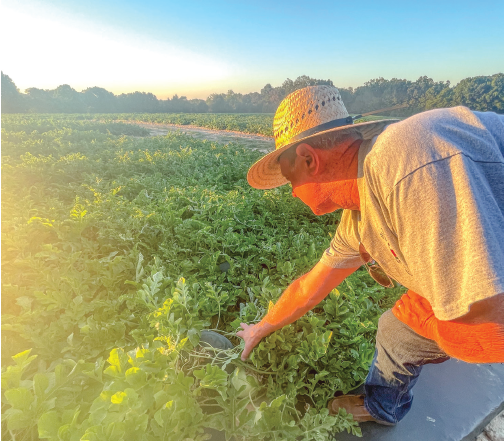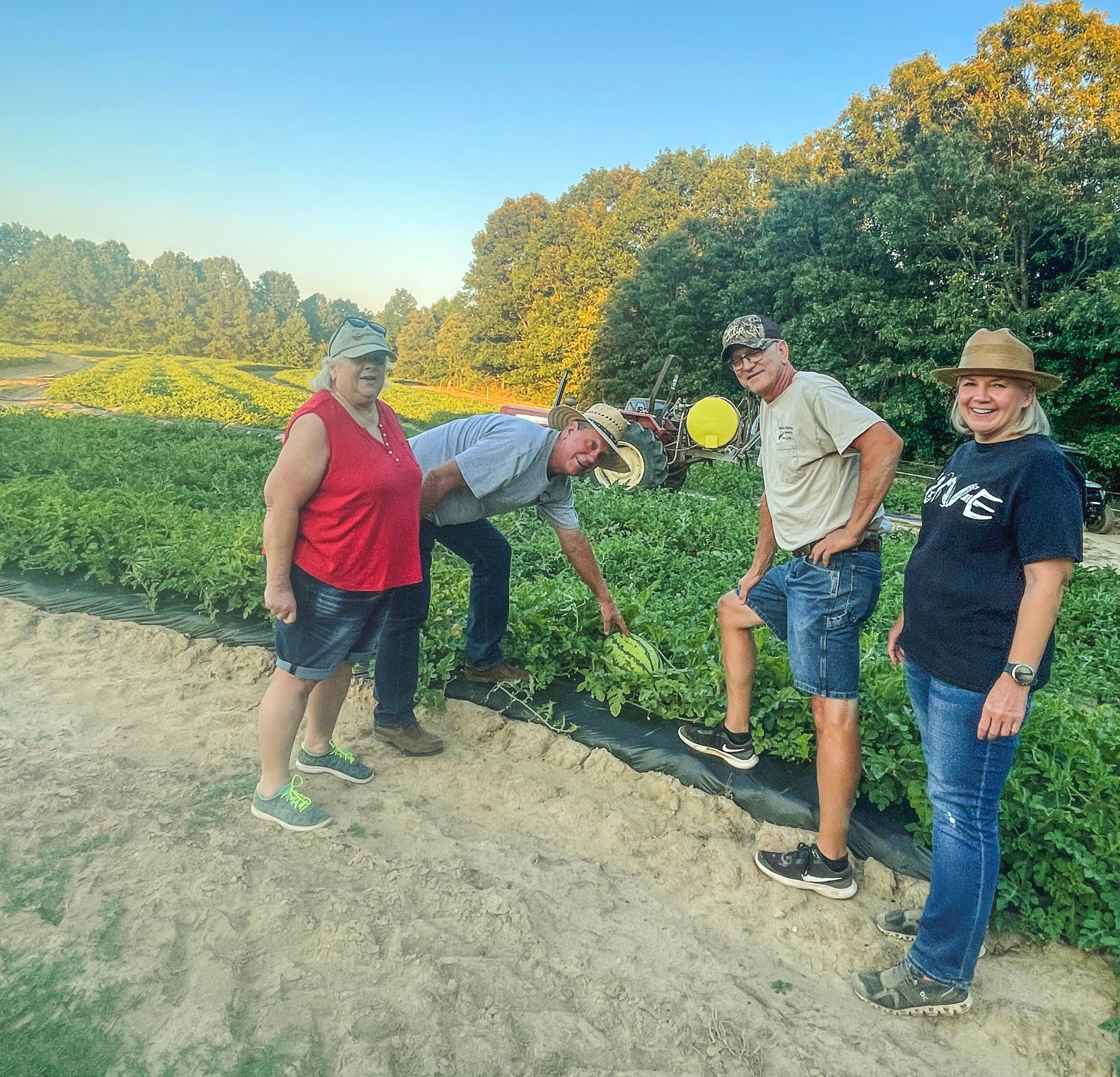By: Tammy Curtis, Managing Editor
For decades, Cave City has been known nationwide for its claim to fame, the sweetest watermelons. As soon as the summer sun beams down on the South, families make their way to lakes and rivers to cool off. But one common seed is the craving for the fruit of summer … the watermelon. These green rinded beauties are an iconic piece of many summer family get togethers. The first ones out of the field bring families out of the backroads and cities alike to be among the first to experience the fruits of the farmer’s labors around the first to middle of July. Most don’t realize just how far back the watermelon tradition goes, even predating the 1938 establishment of a growers association and the 1980 creation of the Cave City Watermelon Festival, first as a one day event.
It’s in their roots
Among the growers, are one family who are in their third generation of production of the luscious fruit of summer. The SRC recently spent an evening with Gary and Phillip Johnson and their wives, Becky and Julie, who have been with them every step of the way. They talked about their deep history of farming melons, the challenges, triumphs and even some humorous tales.
Most recognize Gary and Phillip as the Watermelon Men, but in reality, Johnson’s melon production began long before the two men were even a thought.
The proverbial watermelon “vine” was planted when the men’s grandfather, Washington “Worsh” Johnson, first grew melons and cotton on 135 acres at Cave City. In those days, there were no festival, growers association, or even a sticker brand to market the melons. They were sold to brokers, simply by word of mouth, and transported across the nation. Gary and Phillip’s father, Lester, along with seven or eight of his siblings, learned early on how to properly produce a desirable melon. This is a skillset that has been continually improved upon by the Johnsons since the 1920s.
Phillip spoke of his grandfather’s stubborn nature, a trait that at least, in part, led to the success and longevity of his business being carried through to his son and grandsons.
With a wagon and team, Worsh hauled his melons out of the field and placed them in Big Creek near present day North Ridge Road to cool. Brokers would stop and negotiate deals to purchase loads to sell elsewhere. Gary recalled one incident where a broker offered his grandfather a few cents less per pound than he desired. He promptly refused. Gary laughed at his tenacity, admitting sometimes stubborn streaks aren’t all good. “He said, I will let them sit there and rot before I take that.” Phillip laughed, recalling the story, “And that’s exactly what happened.” Their grandmother’s family also grew melons and peddled them door to door after hauling them by wagon to Batesville.
The vine expands
The Johnson watermelon “vine” continued to spread, and Phillip’s parents, Lester and Verba Lee, eventually inherited the “seed”. After returning to Cave City from World War II, Lester became a watermelon farmer in 1945. He first spent a short time working on a construction crew that built the current highway that runs through the city the family has called home since before the early 1920s. Phillip laughed recalling a story his mother told, “They got married on March 30 and were in the watermelon fields on April 1.” Their parents harvested melons until 1976 when Lester became ill.
At the peak of watermelon production during the 1960s, the growers association that was established in 1938 had 127 members with over 1000 acres of melons planted. Gary said, “During this time, they were going more for commercial production … for selling them to large cities like Chicago.” At that time growers rented stalls in a facility near the present day community center. They would unload their melons so the brokers could pick them up without having to waste time going into the fields. “There were days when the brokers would buy them and we would load five or six trailer loads that would go out to Chicago and lots of other places.” Gary explained. In those days, an average grower planted about 30 acres. Currently the Johnsons plant 15 acres each year with 1300 watermelon plants per acre.
In 1976, the “vine” expanded once again to encompass Gary and Phillip as their father guided them in the growing and production process during his illness. At the time, Phillip was 13. The boys did as any good sons would and began to take on the responsibilities of the farm.
Third generation gets the seed
That Spring, Lester taught his sons the ins and outs of watermelon production that he learned from his own father. The goal was to have the young men take over the operation. Sadly, their father passed away in June before seeing the first of what is now the 46th harvest of his sons’ melons and the establishment of Johnson Brothers Watermelons.
“We made a little money and have been doing it ever since,” Gary said. The profits from the crop later paid Phillip’s way through college.
Through the years, they have learned which planting techniques provide the best yield. These include learning optimal plant and row spacing and the biggest innovation since the beginning … utilizing irrigation techniques.
Before implementing irrigation, Phillip explained, “We spent lots of quality time with that garden hoe.” He admitted he was very picky about how it was done. He then began a story about Julie’s participation, one that was originally supposed to be “off the record.” It was so good that Julie agreed it would be a good one to tell regarding things that have led to changes they still use today.
On an extremely hot day, one Julie described as “the seventh circle of hell,” the couple were working in the field after cultivating the rows spaced ten feet apart with a tractor. The remaining one foot section could only be done with manual labor. This meant a garden hoe.
Phillip explained, “I am trying to tell Julie how to do it right, how to do it better. She leaned back on her hoe and looked back at me. After a while when I got done, she grabbed a hold of that hoe and threw it across the field and said, ‘I quit’”. The couple laughed at the recollection of the memory. But, in reality, it was a pivotal moment when, for the sake of their marriage, they were forced to realize they had to find a better way to cultivate near the plants. Gary, laughed and said he told his brother to get her some water.
Innovation triumphs
“That is when we really went to studying how to do things a different way,” Gary said. This included transplanting. Up until that point they had only planted seeds directly in the field. They were placed nine feet apart then, today, they are only three feet apart. That year, the Johnsons attended field days in watermelon fields in Southeast Missouri from Leechville to Hocum, areas where watermelons also grow well.
“For a hillbilly like us to see all those hundreds of acres of beautiful watermelons all exactly the same size because they had all been transplanted on plastic was just amazing to us. When you direct seed, you very seldom get a perfect stand. You have to go back and replant and you get different sizes and the plants are at different phases,” Phillip explained. This changed the way the Johnson’s produced their melons for the first time in history. It also led the brothers to not be as scared to try new things. As a result, they became more innovative in their production process. It wasn’t always successful, but with each step, they learned and improved or changed their growing methods.
It wasn’t until the late 1990s that the Johnson Brothers began utilizing irrigation techniques in their fields. Prior to that, Phillip said, “We just trusted in the Lord and the weather.” Rainfall or lack thereof is detrimental to the production of watermelons.
Their first attempt at utilizing the transplanting technique over seed planting was one of the many trial and error experiences from which the Johnson’s have learned. They ordered
plants from a greenhouse. “We got 2000 plants from a hot greenhouse. They were beautiful hot plants. We dug holes, put water to make a sluice in the ground and then put the plant in. We worked our tails off all day, did it in cold ground, poured cold water in it, packed them in. We were all so excited. We did everything wrong we possibly could,” Gary said. “Every one of them died.” But as with any type of farming, errors are what leads to improvement.

From seed to melon
Phillip said the most labor intensive and important part of the production comes while preparing the soil. This involves discing, cultivating, fertilizing and planting that typically begins in April. The seeds are started in the greenhouse in March. After the harvest, pulling of the plastic and planting grass on the fields carries their work into October or November. The harvest is the easiest part, according to the brothers.
Prior to planting, they use a machine to lay down the black plastic and drip tape that will carry water to the plants after they are transplanted. The plants will have established a root ball in about five or six weeks, and are solid enough to be transplanted.
The Johnson Brothers utilize a waterwheel transplanter for this part of the production. The machine is equipped with a spike in the center that makes a hole in the plastic. It then puts about a cup of water in the hole and Julie and Becky sit on the back of the machine and place the rooted plants in the ground one by one. After the plant sets the melon, or blooms, it is ready to harvest in 30-35 days. From planting in the greenhouse to harvest usually takes about 90 days, depending on rainfall amounts and the variety of melon.
The Johnson Brothers also grow cantaloupes and typically employ four or five teenagers to help get the melons out each summer. No one picks the watermelons but Gary and Phillip. “We have confidence in our picking. Our goal is to pick them at the perfect stage before they go into the over ripe stage. When a watermelon is cut off the vine, it is as good as it ever will be, it won’t keep ripening,” Gary explained. The Johnson’s reputation is based on the sweetness and perfection of their melons and they don’t want to put the responsibility of cutting them off the vine on anyone else.
Most asked melon question
There is always one question most people want to know about watermelons. Julie said, “There are no female melons,” laughing in anticipation of the question, but stating it is one so many people ask. Most actually want to know how to select the best and sweetest melon. Phillip said before harvesting, they first “thump, pat, roll and then finally cut them off the plant.” Julie explained “You want that melon to sound hollow. You want the stem to be green with a white spot on the belly.” Gary added, “Some of the spots are also yellow to brown depending on the variety of melon.”
“It hasn’t always been easy. That is what is so amazing, the last few years, people come to us and we don’t take that for granted.” – Phillip Johnson
Customers Credited
Julie said she credits their customers with being the main reason their business has remained successful. “We have very loyal people. Last night, I had a Facebook message from a guy driving four hours to get watermelons. I have people from Dallas and Chicago drive all the way to Cave City, Arkansas just to come to our place get melons. That is a big deal to us. We try really hard to produce a great product. We are very grateful that people like what we produce,” Julie said.
Phillip added, “We are not just selling a product. People don’t have to have watermelons to live. It is something you are going to enjoy. They are going to take it home to family, to the river, the lake. It is about an event, about happiness. It is not just a piece of fruit, it’s more than that, it’s a memory.” He said that is why they try so hard to ensure their melons come off at the perfect time.
Phillip went on to explain that in the early days it was hard to sell a watermelon. In the beginning, they took trips to sell melons. “It hasn’t always been easy. That is what is so amazing, the last few years, people come to us and we don’t take that for granted.”
Each year as soon as they arrive with the first loads, their parking lot is flooded with customers before the melons can even be weighed and stickered. “It’s worse than Black Friday at Walmart,” Julie laughed. Sometimes the lot is so full the melon trucks can’t get in to unload.
Besides producing quality melons, Julie said the trademark sticker for registered users that brands the melons has helped bring customers to their stand. Julie is one of the only growers who began utilizing social media to promote their products and she feels the videos she posts have helped more than anything.
Beware of counterfeits-
But with every good thing comes some form of negative issue.
Perhaps Oscar Wilde said it best “Imitation is the sincerest form of flattery.” The round “Genuine Cave City Watermelon” sticker, designating the brand is sometimes counterfeited. This is unfair to the growers who, like the Johnsons, put hundreds of hours of work into their harvest, not to mention tens of thousands of dollars they have invested in the crops. Every year, they have to deal with imitation melons. This and resellers marking the melons up to make so large of profit that the cost of their fruit is much higher than the Johnsons melons at their stand. This often makes others think all Cave City melons are priced as high as that of the resellers who are selling them out of town. But this is an issue they deal with and overcome by having loyal customers and some of the sweetest melons in the state.
In it for the long haul
Over the years, the Johnsons have overcome any obstacle in their path. Years of hard work, dedication, innovation and building a brand has put them at the top of the crop in Cave City watermelon production for nearly a half century.
The Johnsons invite the public to enjoy the fruits of their harvest, arriving at their stand this week. It is located two and a half miles North of Cave City on Hwy. 167.
The Cave City Watermelon Festival, on which Julie serves with a committee since 2015, will be held at the Cave City Park July 28-30. This free, family friendly event is chocked full of food, entertainment and vendors, not to mention the free, ice cold melons on Saturday.
So bring your family and lawn chairs and celebrate the labor and goodness of one of the greatest contributors to the Sharp County economy.

